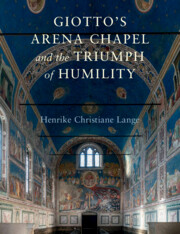Book contents
- Giotto’s Arena Chapel and the Triumph of Humility
- Giotto’s Arena Chapel and the Triumph of Humility
- Copyright page
- Dedication
- Epigraph
- Contents
- Figures
- Preface
- Acknowledgments
- Introduction
- Chapter 1 A Venetian Dream of Rome and Jerusalem
- Chapter 2 1300: The Moment of the Jubilee in Rome and in Padua
- Chapter 3 The Powers That Were
- Chapter 4 Giotto’s Painted Reliefs
- Chapter 5 Triumph and Apotheosis, Augustine to Dante
- Epilogue
- Appendices
- Notes
- Select Bibliography
- Index
Chapter 1 - A Venetian Dream of Rome and Jerusalem
Published online by Cambridge University Press: 12 January 2023
- Giotto’s Arena Chapel and the Triumph of Humility
- Giotto’s Arena Chapel and the Triumph of Humility
- Copyright page
- Dedication
- Epigraph
- Contents
- Figures
- Preface
- Acknowledgments
- Introduction
- Chapter 1 A Venetian Dream of Rome and Jerusalem
- Chapter 2 1300: The Moment of the Jubilee in Rome and in Padua
- Chapter 3 The Powers That Were
- Chapter 4 Giotto’s Painted Reliefs
- Chapter 5 Triumph and Apotheosis, Augustine to Dante
- Epilogue
- Appendices
- Notes
- Select Bibliography
- Index
Summary
Highlighting its prominent location on the site of the ancient Roman arena in Padua, the oratory of Santa Maria della Carità has traditionally been called the Cappella dell’Arena or Arena Chapel (Figs. 1.1–1.2). Part of a new family palace commissioned by Enrico Scrovegni, the chapel was built and decorated by Giotto in the years following the Roman Jubilee of 1300, after the Tuscan painter had worked for Pope Boniface VIII as his papal court artist in Rome. The construction of Santa Maria della Carità, so closely connected to Giotto’s murals, was most likely masterminded and supervised by Giotto himself. The building can be dated between 1300 and 1303, and the parameters for the frescoes have been set between 1303 and 1307.2 The overall structure and proportions of the Arena Chapel?s nave are akin to two triumphal arches placed in succession.3 The barrel-vaulted core interior is divided into two precincts – public and private – with two respective entrances. Formerly adjoining Palazzo Scrovegni, the chapel stands projecting out from the elliptical plan of the ruins of the ancient Roman arena.4 The chapel’s building history, based upon some documented and some obvious physical alterations undertaken during construction, has been profoundly debated.5 Walter Euler describes the effect of the interior as surprisingly grand for its height, which is only about one-and-a-half times its width. In this simple geometry of the classical barrel vault, the cross section equals a square with a semicircle on top of it.6
- Type
- Chapter
- Information
- Giotto's Arena Chapel and the Triumph of Humility , pp. 29 - 52Publisher: Cambridge University PressPrint publication year: 2023



